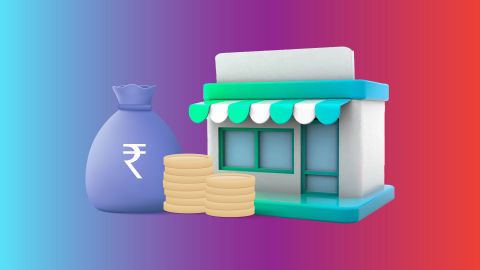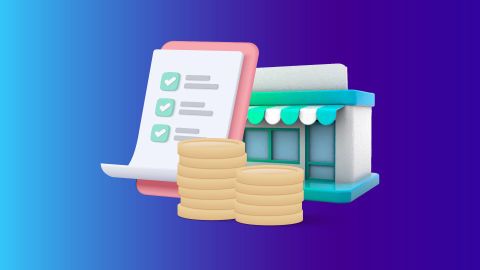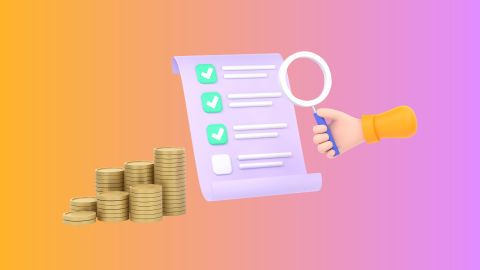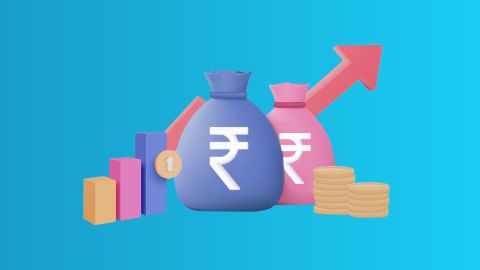How does a capital expenditure work?
Capital expenditure, commonly known as CapEx, refers to the funds a company spends to acquire, upgrade, or extend the life of long-term physical assets such as buildings, machinery, and equipment. These assets are not consumed within a single financial year but are used over time to support business operations. As a result, CapEx is not recorded as an immediate expense in the income statement. Instead, it is classified as a fixed asset under the company’s balance sheet in the property, plant, and equipment (PP&E) section.
Check your pre-approved business loan offer to see if you can access instant funding for such critical purchases.
For small enterprises planning such asset purchases, accessing additional funds through financial products like a micro loan can provide the necessary capital without straining operational cash flow.
To account for the gradual usage of the asset, the cost is spread out over its useful life through a process called depreciation. For example, if a company purchases a piece of equipment for Rs. 10 lakh with an expected life of 10 years, it will record Rs. 1 lakh as depreciation each year. This method follows the matching principle in accounting, which ensures that the cost of an asset is aligned with the revenue it helps generate over time.
CapEx is distinct from operating expenses (OpEx), which include day-to-day business costs such as rent, salaries, utilities, and administration. Unlike CapEx, OpEx is fully recorded as an expense in the same accounting year in which it is incurred. While OpEx maintains daily operations, CapEx focuses on building capacity and long-term growth, making it a vital part of strategic financial planning.
Different types of Capital Expenditure
Capital expenditures can be categorised into several types, each addressing different strategic needs of a business:
- Acquisitions: Purchasing new assets that add value to a company’s operational strength for more than one fiscal period.
- Upgrades: Spending on improvements to existing assets to increase their capacity or efficiency.
- Renovations: Revitalising existing assets to modern standards, often to increase their life or to meet regulatory requirements.
- Expansion: Investments to increase the scale or scope of the business operations.
- Technology Investments: Outlays on advanced technology to improve competitive positioning or operational efficiency.
These categories of CapEx are crucial for strategic growth and operational sustainability.
Acquisitions
In the context of CapEx, acquisitions refer to significant investments made to purchase fixed assets or an entity's stake that will directly contribute to the company's long-term revenue generation. Unlike operating expenses, which recur daily or monthly, acquisitions are typically large-scale investments made with the goal of expanding the firm's productive capacity or market reach. This could include purchasing new machinery, facilities, or even entire companies. These expenditures not only increase the asset base of a company but also have the potential to open new avenues for income generation and market expansion.
Upgrades
Upgrades as a type of CapEx involve the allocation of resources towards improving existing company assets to boost their efficiency or capacity. This could include investing in enhanced technology for a manufacturing line, upgrading software systems to more sophisticated versions, or retrofitting buildings with modern energy-efficient systems. These investments help companies stay competitive in a rapidly evolving business environment, ensure compliance with new regulations, and can lead to significant long-term savings or improved output.
Renovations
Renovations, as a type of Capital Expenditure (CapEx), involve the updating or modernisation of existing facilities, machinery, or systems within a company. These improvements are aimed at enhancing efficiency, complying with new regulations, or simply revitalising old spaces for better productivity and working conditions. Renovations can include everything from refurbishing office spaces and overhauling production lines to upgrading IT systems or improving building infrastructure. Investing in renovations not only extends the useful life of the company's assets but also contributes to greater operational efficiency and can positively impact the organisation's overall performance.
Examples of Capital Expenditure
Some common examples of capital expenditure include:
- Construction of a new office or commercial building
- Purchase of land for future development
- Investment in machinery, tools, or computing equipment
- Office furniture and fixtures
- Company-owned vehicles
- Acquiring patents, trademarks, or licences
Professionals running enterprises, such as consultants or freelancers, can always opt for a personal loan for self employed individuals when planning capital investments like home offices or vehicle purchases for business use.
As previously explained, capital expenditure is reported under the investing section of a company's cash flow statement. Unlike routine expenses, capex is not shown on the income statement in full during the year of purchase. Instead, the cost is spread across the asset’s useful life through depreciation or amortisation.
Here’s a simplified illustration to understand how capital expenditure is reflected in financial reporting:
Let’s take some sample cash flow statements for an industry as on 31st March 2025
Particulars
|
Amount (Rs.)
|
Cash flow from operating activities
|
5,45,00,000
|
Cash flow from investing activities
|
-1,35,00,000
|
Net change in cash
|
3,10,00,000
|
Opening cash balance
|
4,90,00,000
|
Closing cash balance
|
8,00,00,000
|
Free cash flow calculation
Particulars
|
Amount (Rs.)
|
Operating cash flow
|
5,45,00,000
|
Capital expenditure
|
-1,70,00,000
|
Free cash flow
|
3,75,00,000
|
This example shows how capital expenditure directly affects free cash flow, which is an important indicator of a company's financial flexibility and investment potential.
Importance of Capital Expenditure
Capital expenditure plays a critical role in shaping long-term economic growth and business development. It involves investment in physical assets that enhance a business’s production efficiency, infrastructure quality, and revenue potential over time. By creating durable assets, CapEx also boosts employment generation, supports economic expansion, and increases future production capacity. Additionally, loan repayments are treated as capital payments since they help reduce a business’s financial liabilities.
In the Union Budget, capital expenditure is categorised into four types: estimated expenditure, revised expenditure, provisional expenditure, and actual expenditure.
- Estimated expenditure refers to the budgeted allocation presented on February 1 each year, outlining how funds will be spent to boost economic growth.
- Revised expenditure reflects updates made to the estimated figures during the financial year.
- Provisional expenditure is an unaudited estimate of spending and receipts for the current year.
- Actual expenditure is released post audit and verification.
The table below shows the expenditure figures for the financial years 2023-24 and 2024-25:
Year
|
Type of Expenditure
|
Amount (in Rs.)
|
2023–24
|
Estimated Expenditure
|
10,00,961
|
2023–24
|
Revised Expenditure
|
9,50,246
|
2023–24
|
Provisional Expenditure
|
9,48,506
|
2024–25
|
Budget Expenditure
|
11,11,111
|
Negative vs Positive CapEx
Aspect
|
Negative CapEx
|
Positive CapEx
|
Cash flow impact
|
Means money is coming into the company.
|
Means money is going out of the company.
|
Investment strategy
|
The company is selling assets, getting rid of non-important parts, or reorganising.
|
The company is spending to grow, expand, or improve its long-term assets.
|
Investor perception
|
May worry investors, as it can show management isn’t confident about the company’s future.
|
Seen as a good sign that management is hopeful and investing in the business’s growth.
|
Examples
|
- Selling an old or unused building.
- Selling a part of the business that’s not core.
- Selling assets to get cash.
|
- Buying new machines.
- Building new offices or factories.
- Investing in new technology or software.
- Buying another company or a patent.
|
Difference between capital expenditure and revenue expenditure
The table below highlights the key distinctions between capital expenditure (CapEx) and revenue expenditure (RevEx), focusing on their purpose, treatment, and impact on a firm’s financials.
Parameter
|
Capital Expenditure (CapEx)
|
Revenue Expenditure (RevEx)
|
Purpose
|
Incurred to acquire or upgrade long-term assets that support future operations
|
Incurred to manage day-to-day business activities and maintain current operations
|
Duration
|
Long-term, offering benefits that extend beyond the current financial year
|
Short-term, with benefits typically confined to the same accounting period
|
Financial Reporting
|
Shown in the cash flow statement and recorded under fixed assets in the balance sheet
|
Reflected in the income statement; not carried over to the balance sheet
|
Business Impact
|
Aims to expand or enhance a firm’s capacity or infrastructure
|
Helps to preserve the company’s operational efficiency and generate routine income
|
Depreciation
|
Depreciated annually over the asset’s useful life
|
Not subject to depreciation
|
Capitalisation
|
These expenses are capitalised as part of the company’s asset base
|
Not capitalised and are fully expensed in the same year
|
Frequency
|
Usually occurs irregularly or at longer intervals
|
Regular and recurring in nature
|
Strategic Benefit
|
Contributes to long-term growth and development
|
Supports ongoing operations but does not directly contribute to asset building
|
Benefits and Risks of CapEx
Capital expenditure decisions can drive long-term value but also involve significant financial commitment and risk. Strategic evaluation is essential before investing.
Benefits:
- Long-term growth: Investments in CapEx can lead to expansion of business capacity and long-term growth in revenues.
- Tax benefits: Many jurisdictions allow businesses to deduct CapEx depreciation from their corporate income.
- Increased efficiency: Upgrading older equipment or facilities can lead to increased operational efficiency.
Risks:
- High upfront costs: Capital expenditures often require large upfront costs, which can strain a company's finances.
- Obsolescence risk: Rapid technological changes can render new capital investments obsolete quickly.
- Return on investment (ROI) risk: There is always a risk that CapEx investments do not generate the anticipated return.
Balancing these benefits and risks is crucial for strategic financial planning.
Challenges of capital expenditure
Capital expenditure (CAPEX) presents several challenges for businesses, particularly in the Indian context.
Measurement Issues: One significant challenge is accurately measuring the costs and benefits associated with capital investments. Businesses and financial experts often struggle to quantify these factors precisely, making it difficult to evaluate the potential returns of a capital expenditure proposal.
Unpredictability: Large capital investments are typically made with the expectation of generating predictable outcomes. However, these projections often fail to meet expectations due to the inherent uncertainties in estimating future costs and benefits. To address this, businesses must consider potential risks and develop strategies to mitigate these uncertainties effectively.
Temporal Spread: CAPEX involves costs and benefits that are spread over an extended period. This long-term nature complicates the estimation of discount rates and the establishment of present value equivalence. In the Indian context, where infrastructure projects and industrial investments can span decades, this temporal spread can significantly impact financial planning and decision-making.
Overall, these challenges require careful analysis and strategic planning to ensure that capital expenditures contribute positively to a company’s growth and financial health.
How to Calculate Capex
To calculate Capital Expenditures (CapEx):
- Identify Net Increase in PP&E: Determine the net increase in the property, plant, and equipment (PP&E) accounts from the balance sheet. This involves subtracting the PP&E value at the beginning of the period from the PP&E value at the end of the period.
- Add Total Depreciation Expense: Locate the total depreciation expense for the same period, as recorded on the income statement. Add this amount to the net increase in PP&E.
- Adjust for Depreciation: Include depreciation in the calculation because it reduces the book value of assets but does not involve an actual cash outlay.
- Calculate CapEx: The result of these calculations represents the total amount spent on acquiring or upgrading physical assets during the accounting period.
CapEx Formula
The formula to calculate CapEx is fairly straightforward:
CapEx = PP&E at the end of period − PP&E at the start of period +Depreciation for the period
Where PP&E stands for property, plant, and equipment. This calculation helps companies determine their total capital expenditures over a given accounting period by comparing the net increase in PP&E and accounting for depreciation.
Example of Capex Calculation
To understand how CapEx is calculated, consider a company that starts the year with Rs. 10 lakh in PP&E and ends the year with Rs. 15 lakh. During the year, it reports Rs. 2 lakh in depreciation. The CapEx calculation would be: CapEx = (Rs. 15 lakh −Rs. 10 lakh) + Rs. 2 lakh = Rs. 7 lakh
This indicates that the company invested Rs. 7 lakh in capital expenditures during the year.
CapEx vs. OpEx
Feature
|
Capital Expenditure (CapEx)
|
Operating Expenditure (OpEx)
|
Purpose
|
To buy, maintain, or improve long-term assets like buildings, machines, or equipment that will be useful for a long time.
|
To pay for everyday running costs of the business.
|
Timing
|
Usually large payments made occasionally.
|
Regular payments made often, like monthly or quarterly.
|
Accounting
|
Recorded as an asset on the balance sheet and its cost is spread over several years through depreciation.
|
Recorded as an expense in the same year it is paid.
|
Tax implication
|
Tax benefit is spread over many years through depreciation.
|
Fully deductible in the year it is spent, giving immediate tax relief.
|
Financial impact
|
Needs a big payment upfront, which can affect cash flow but adds long-term value.
|
Smaller, regular payments help manage cash flow and budgets easily.
|
Approval process
|
Usually needs approval from several management levels because of the high cost and long-term effect.
|
Approval is simpler, covered under the regular operating budget.
|
Examples
|
Buying vehicles, machines, buildings, software licences, or patents.
|
Paying rent, electricity bills, office supplies, staff salaries, and cloud service subscriptions.
|
Strategies for efficient capital expenditure budgeting
Big capital projects with large expenses can easily go out of control if not handled well and can cost a company a lot of money. But with good planning, the right tools, and proper project management, this can be avoided. Here are some tips to make sure capital expenditure budgeting is done efficiently:
Plan Before You Start
Before starting a capital project, it is important to prepare well. Otherwise, costs might go beyond the budget. You should clearly understand the project’s scope, set realistic deadlines, and get the plan reviewed and approved. Also, decide how many internal resources like people, materials, money, and services will be needed. The more details you have early on, the more accurate your budget will be.
Think Long Term
At the beginning, decide if you will buy the asset by borrowing money or by saving funds. Saving means you might have to wait before buying the asset. Borrowing can increase your debt and may affect your ability to borrow in the future. Both ways have pros and cons and might suit different projects.
Use Good Budgeting Software
Right from the start, pick a reliable and easy-to-use software for budgeting. The choice depends on the size of the project, speed of the software, and how much chance there is for mistakes.
Collect Accurate Data
Good data is very important to manage capital projects well. To make a realistic budget and useful reports, you need to gather correct and trustworthy information.
Get the Right Level of Detail
Too much detail takes a lot of time to gather and can make the budget old before it’s done. Too little detail makes the budget unclear and less helpful. Find the right balance between too much and too little information.
Set Clear Rules
Since many people, departments, or locations might be involved, it’s important to have clear rules that everyone follows. This will help keep the budget on track.
Conclusion
In conclusion, effective management of CapEx is crucial for driving business growth and maintaining competitive advantage. Companies must carefully plan and execute their capital expenditure strategies to balance between expanding their operational capabilities and maintaining financial health. Considering a business loan can be a strategic move to fund large-scale investments without compromising cash flow, ensuring that businesses can continue to innovate and expand in a sustainable manner.
Helpful resources and tips for business loan borrowers






